Bridging Past and Present in Pasir Ris
Once dotted with plantations and mangrove swamps, Pasir Ris is today a bustling residential town with modern facilities and amenities.
By Asrina Tanuri
.jpg)
Sun, sand, sea and sax – the popular Malay song “Bila Mama Pakai Celana” had it all. Set to a cha-cha beat, the song was written by actor, musician and filmmaker P. Ramlee and featured in the 1959 film Saudagar Minyak Urat (Love Crazy).
In the film, actor Aziz Sattar sings this song – whose title roughly translates as “When Mother Wore Pants” – on a beach surrounded by a bevy of ladies in swimsuits who are gyrating their hips as they twirl hula hoops. A saxophone dangles around his neck, which he holds occasionally but never seems to actually use.
Produced by the Shaw Brothers’ Malay Film Productions, this particular scene was shot on the grounds of a beachside hotel in Pasir Ris.1 The now largely forgotten Pasir Ris Hotel on Elias Road was owned by well-known hotelier Ho Meng Quee. Before he took over the place in the 1950s, the building had been the beachfront holiday residence of wealthy Jewish entrepreneur Joseph Aaron Elias, who was also a Justice of the Peace (he and his brother Ezra Aaron Elias gave Elias Road its name).2
It is not surprising that the producers of this lightweight comedy would have chosen Pasir Ris to capture a laidback beach vibe. For much of Singapore’s postwar years, the white sands of Pasir Ris drew city folk looking for a quiet, peaceful respite. At one time, Pasir Ris boasted two seaside resorts and even had a museum of corals and seashells. Its remote location added to its allure, in the way that holidaymakers today seek out beach holidays in Bintan, Tioman and Phuket.
These days, Pasir Ris is no longer quite as quiet and remote. Over 100,000 people live in bustling Pasir Ris town, which is well connected to the rest of Singapore thanks to the MRT (it is a speedy 33-minute train ride from City Hall MRT station). Downtown East, which styles itself as a premier lifestyle, recreational and entertainment hub, draws large crowds on weekends and school holidays. And although it still boasts sandy beaches, if you mention “white sands”, you are more likely to be directed to the six-storey shopping mall next to Pasir Ris MRT station.
An Idyllic Enclave
One of the earliest mentions of Pasir Ris is in an 1844 map by John Turnbull Thomson, the Government Surveyor for the Straits Settlements. In that map, the area was labelled as Passeir Rice. Other 19th century maps use variant spellings such as Passir Ris and Passir Risa. Charles Burton Buckley’s 1902 book, An Anecdotal History of Old Times in Singapore, refers to the place as Passier Reis.3
The origin of the name Pasir Ris is unknown though. According to a study by H.T. Haughton published in the Journal of the Straits Branch of the Royal Asiatic Society in 1889, the name could have been derived from a combination of the Malay words pasir (sand) and hiris (shred).4
Pasir Ris was once a low-lying and undeveloped area.5 Maps from the 1950s to 1970s show that Pasir Ris was then occupied mainly by coconut and rubber plantations, mangrove swamps and ponds, and dotted with Malay kampongs and Chinese villages. The kampongs in the area included Kampong Loyang, Kampong Pasir Ris, Kampong Elias, Kampong Teban, Kampong Beremban and Kampong Sungei Blukar. Two waterways, Sungei Api Api and Sungei Tampines, used to flow through the area.6
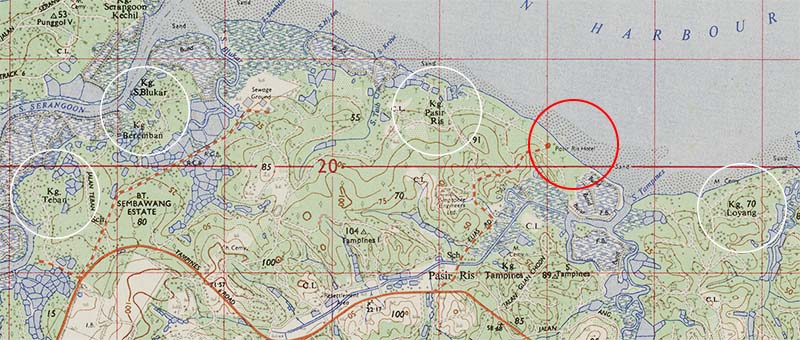
Apart from rubber tapping and fishing as their livelihoods, the Malay villagers also produced belacan (fermented shrimp paste) made from udang geragau (small shrimps) caught at Sungei Api Api and Sungei Tampines during high tide. Kampong Tampines, located on Jalan Guan Choon and Tampines Road, was a popular filming location in the 1950s and 1960s for Malay films such as Hantu Jerangkong (The Skeleton Ghost), Antara Dua Darjat (Between Two Classes) and Batu Belah Batu Bertangkup (The Devouring Rock).7
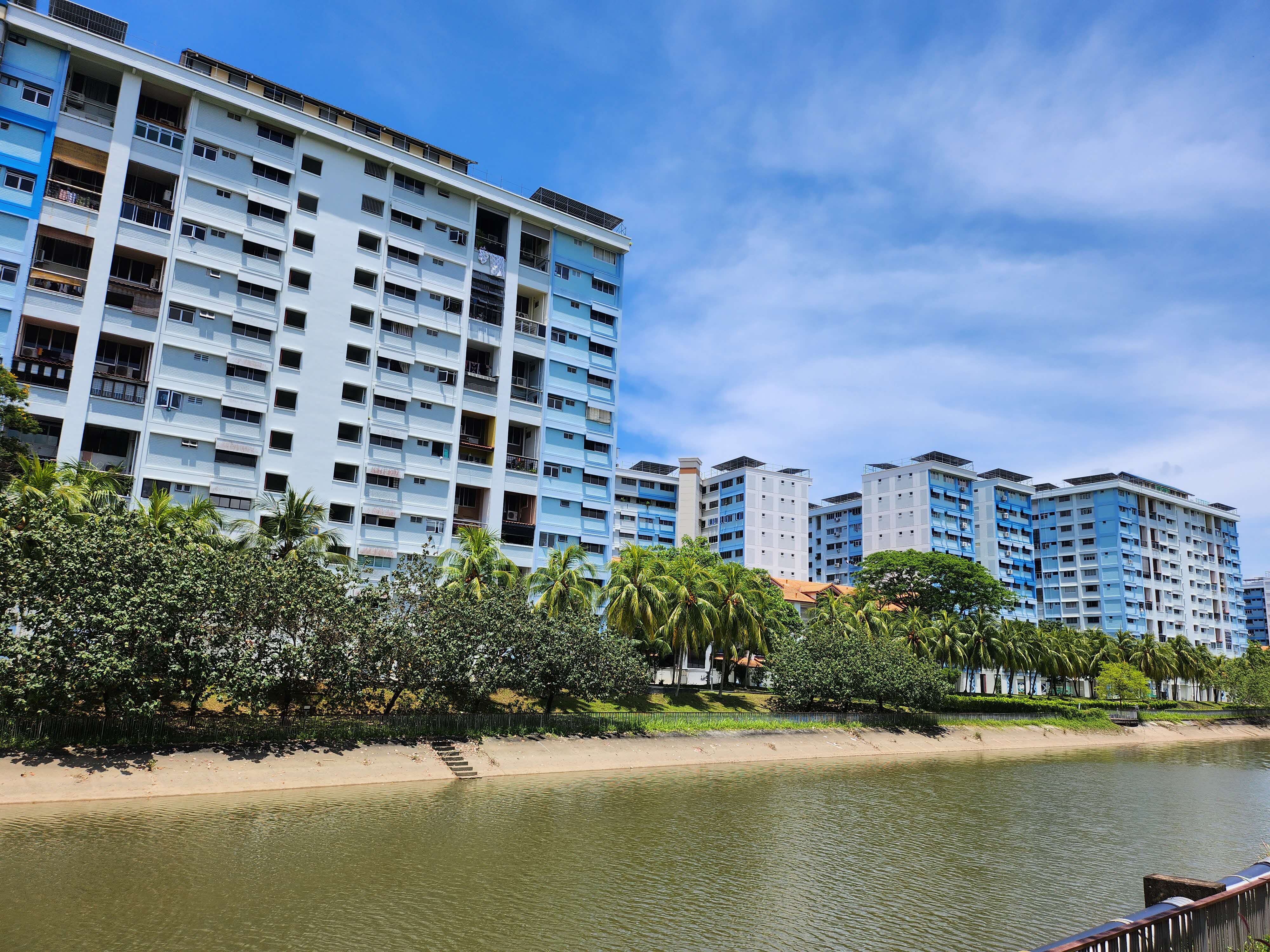
Interestingly, Pasir Ris was used as a film location very early on. In 1913, French filmmaker Gaston Méliès shot The Poisoned Darts in the area. An advertisement that ran in Moving Picture World magazine proudly proclaimed that it was “produced in the jungles of Passir Riz [Pasir Ris], a suburb of Singapore, Strait Settlements, Asia, employing natives in many of the roles”.8 Author and film director Raphaël Millet, who directed a documentary on Méliès, noted that based on the surviving footage of this film, the actors were most likely inhabitants of Malay villages in Pasir Ris.9
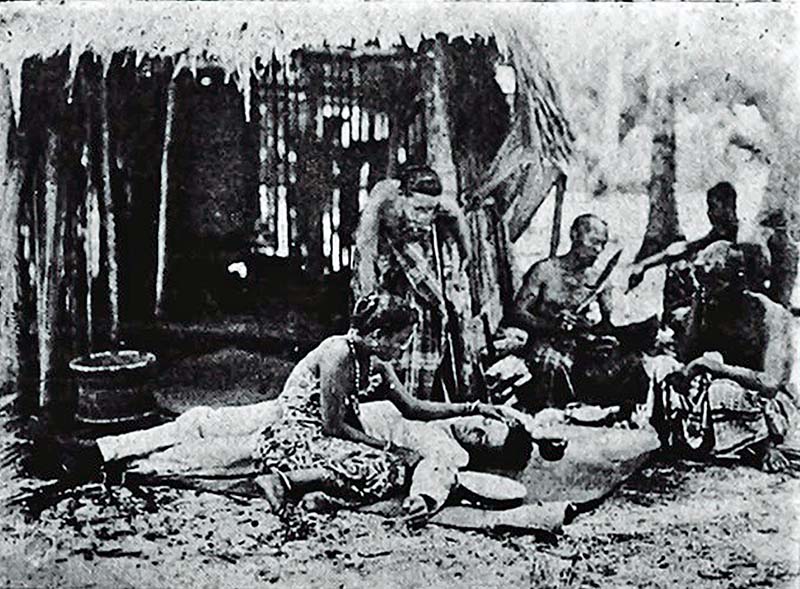
A Seaside Getaway
Pasir Ris was known for its recreational amenities that attracted local holidaymakers and tourists. Pasir Ris Hotel, the location for the song “Bila Mama Pakai Celana” was a pioneer in beachfront development in Pasir Ris.10
A Straits Times advertisement on 16 May 1952 described the hotel as “Singapore’s Premier Pleasure Resort” that offered “the clearest, beautiful, palm-fringed beaches, swimming, boating and lawn tennis”. Officially opened on 17 May, the hotel comprised 35 fully furnished rooms fitted with modern sanitation, and provided amenities such as a dance hall, tennis courts and an enclosed swimming pagar (fenced-in pool; pagar means “fence” in Malay).11
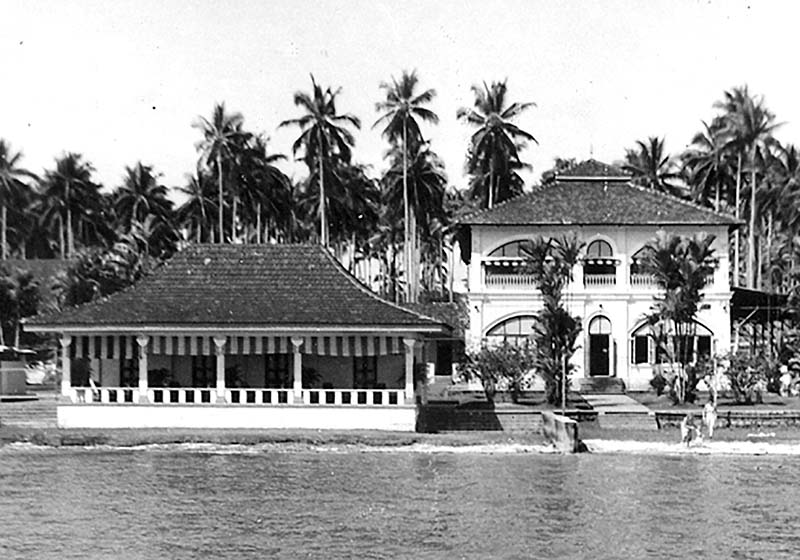
However, seven years later, the hotel was converted into a transit accommodation for the personnel of the British Royal Air Force and their families. Although the hotel subsequently reopened to the public in 1966, it never regained its former glory and struggled to attract guests.12
In May 1971, New Nation reporter Wendy Hutton described the hotel as a “faded gentlewoman, now reduced to taking in paying guests, who occasionally dreams of the days of her youth and beauty when young men sipped champagne from her dancing slippers”.13
The hotel hung on for another decade before finally shuttering on 31 December 1983. Speaking to the Straits Times that year, Robin Tan, the assistant front manager, recalled the hotel in its heyday. “I remember coming to this place when I was a little boy and seeing only ang mohs (Caucasians) around. It was very exclusive, somewhat like the Singapore Cricket Club. And the sea came right up to the hotel’s doorsteps.”14
The nearby Golden Palace Holiday Resort, which opened in 1969, was another popular spot for holidaymakers. The 20-acre resort at the now-expunged Jalan Ang Siang Kong off Tampines Road was touted as an “ideal retreat for fishing, boating, picnics and parties” with a “beautiful panoramic scenery”. It had chalets, pavilions, restaurants and a nightclub. One of the resort’s key offerings was its boating and fishing pond, which was once a sand quarry.15 According to Pasir Ris resident Law Yap Teck, who visited the resort when he was in his 20s, “[it] was a place where people came for an eye-opening experience. To have fun, row boats and stay in the holiday resort”.16
The resort wound up in 1971 after a petition by one of the directors over alleged mismanagement by the company’s chairman. In 1973, the government acquired the resort for $870,000, with plans for it to be used for fish-breeding experiments. Today, the resort’s former site forms part of Pasir Ris Park. The pond was converted into a commercial saltwater fishing pond, which opened to the public in October 1990.17
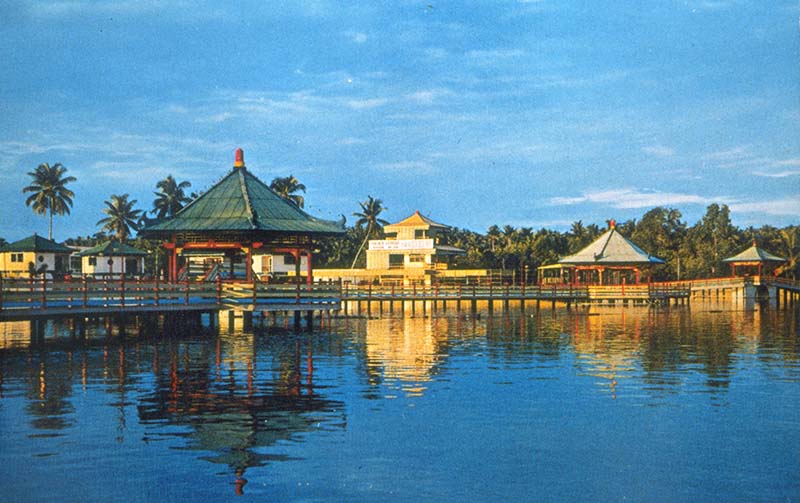
While Pasir Ris Hotel and Golden Palace Holiday Resort targeted a more affluent clientele, the People’s Association Holiday Flats offered affordable rentals that became popular among local families. A three-storey block comprising 30 holiday flats was officially opened by then Minister for the Environment Lim Kim San on 11 November 1973.18
These flats were intended to serve the “average wage-earners” and provide a beach holiday “at a cost within their means”. The daily rate was $7 for a two-room unit and $10 for a three-room unit. Each flat came with a living and dining room, and kitchen facilities.19 Noraini Anastasi, who stayed there in 1988, recalled that “[t]he seaside scenery is super. My only complaint: mosquitoes. We should have brought mosquito coils but, alamak, we forgot”.20
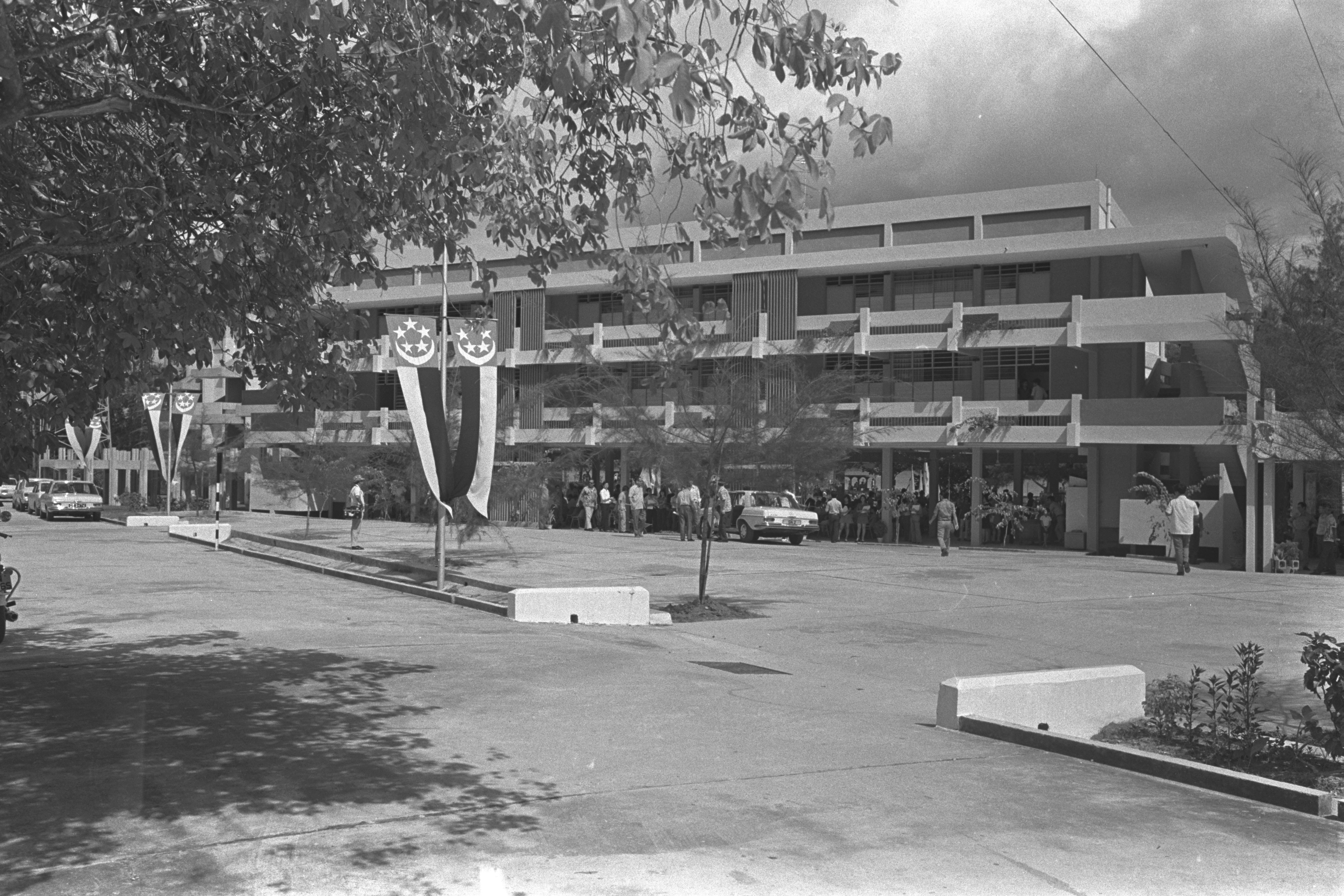
In addition to the holiday flats, the People’s Association built a sea sports centre to cater to water sports enthusiasts. The Pasir Ris Sea Sports Centre on Elias Road opened in August 1987 “for Singaporeans who love the sun-and-sea type of sports”. Today, the centre is known as PAssion WaVe @ Pasir Ris and offers activities such as dinghy sailing, kayaking, abseiling and sports climbing.21
With its proximity to the sea, water skiing was a popular sport in Pasir Ris back in the day. In February 1955, Pasir Ris Hotel hosted the Malayan Waterski Association’s first water skiing gala, which saw the construction of a 30-foot-long wooden ramp raised four feet above the water. The hundreds of spectators were entertained by the “spectacular tumbles” from the contestants. Pasir Ris was chosen “because it is safe for families to bring along children and also because there is plenty of parking space”, according to the event spokesperson, A.C. Cooper.22
From the late 1960s to 1970s, Pasir Ris was also home to two tourist attractions – Villa Saujana and Dari Laut – located at Jalan Loyang Besar. Dari Laut, which means “from the sea” in Malay, was a museum showcasing 10,000 species of corals, seashells, fishes and other wildlife specimens.
Founded by beachcomber Johnny Johnson and marine enthusiasts John Langham and Jack Fisher, the museum was officially opened by then Finance Minister Goh Keng Swee in December 1969. It was initially accessible only to American troops on rest and recreation here from Vietnam. When the programme ceased a couple of years later, Dari Laut was opened to all tourists. Johnson eventually closed the museum and went on to supervise the establishment of the Coralarium at Sentosa with Fisher in 1974.23
Dari Laut’s neighbour was Villa Saujana, the seaside residence of Englishman Ernest Smith, who was the former assistant manager at Raffles Hotel. (“Saujana” is a variation of suasana, Malay for “pleasant environment and view”.) Smith had opened his home, which had a Malay kampong atmosphere, to tourists at $30 a head, inclusive of dinner, cultural shows and drinks. In the early 1970s, Villa Saujana was said to be one of the top tourist attractions in Singapore.24
A Park for All
In 1956, the Singapore Rural Board announced plans to develop 14.5 acres of land in Pasir Ris to provide more facilities for beachgoers. The plan included clearing coconut trees; building an access road, changing rooms and shower facilities; and repairing the seawall. Works were completed in 1958, and Pasir Ris beach park was officially opened on 17 August 1958 by then Chief Minister Lim Yew Hock.25
From the late 1970s, Pasir Ris beach underwent further developments, which included 44 hectares of land reclamation. Landscape and park specialists from Japan were engaged to develop the park. It would have a pond, flower gardens, jogging and cycling tracks, an area for nature walks and boating, a camp site, chalets, a children’s playground, cafeterias and a sports complex.26
In 1984, the Parks and Recreation Department (today’s National Parks Board) embarked on a project to build an 80-hectare regional park stretching from Pasir Ris beach park to Sungei Loyang, making it the second-biggest park in Singapore after East Coast Park.27
Today, the 70-hectare park – which stretches over 3.2 kilometres – provides pony rides, bicycle and barbecue pit rentals, camping sites and water sports facilities. A highlight of the park is the preserved mangrove forest with a mangrove boardwalk and a three-storey tower for birdwatching.28
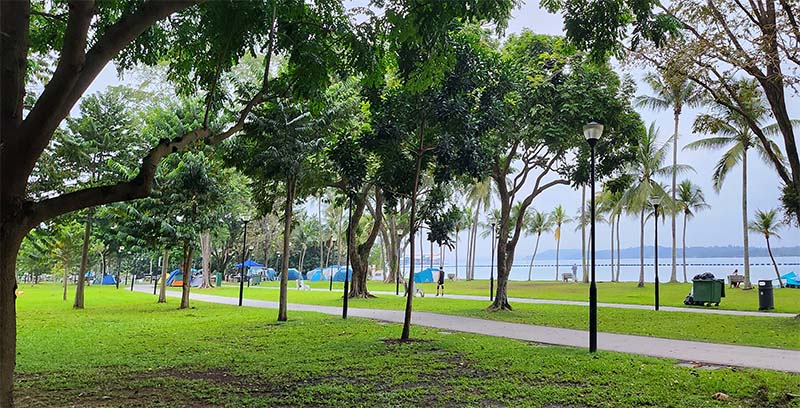
Nature lovers can also visit Lorong Halus Wetland, a former landfill along the eastern bank of Serangoon Reservoir. Officially opened in March 2011, the wetland protects the reservoir water from contaminants caused by landfill waste. Spanning Serangoon Reservoir is the Lorong Halus Red Bridge, a great place to catch the sunset and popular with Instagrammers.29
%20v2.jpg)
A Residential Town
One of the earliest housing developments in Pasir Ris was the 57-hectare Pasir Ris Beach Park Estate. The private residential area, developed by property developer Kong Joo in the early 1970s, comprised 328 bungalows, semi-detached houses and terrace houses located near the former Pasir Ris Hotel site. Residents likened it to living in a kampong, and even harvested shrimps from the sea to make their own belacan and cincalok (fermented shrimp product).30
Happy Tay, president of the Pasir Ris Beach Park Residents’ Association, told the Straits Times in 1988: “The atmosphere in this place is just like a kampung. Even if there is a disagreement, we try to solve it in a friendly manner and no one takes offence if we point out their mistakes. And people genuinely like to help each other.”31 Several of these houses today are owned by the government and private corporations as holiday bungalows for their employees.32
The Housing and Development Board (HDB) announced plans for the development of Pasir Ris New Town in its 1984/85 annual report, with construction slated to begin in 1986. The government had acquired land to build the new housing estate from Bukit Sembawang Rubber Company, Shaw Brothers and a number of private individuals in 1983. To attract potential buyers to the far-flung location, the HDB highlighted amenities such as the MRT system that would take residents to Orchard Road in 30 minutes and the new Pasir Ris Park. “Better-quality flats with better finish and better designs” in Pasir Ris were also cited to boost the estate’s appeal.33
The town welcomed its first residents in 1988 and was dubbed a “yuppie neighbourhood with high expectations” by its Member of Parliament Charles Chong, as most of the residents were mainly young families.34 Airline relations manager Nur Aireen Abdullah and her family moved into a five-bedroom flat in Pasir Ris Drive 6 in June 1989. She recalled: “There were limited bus services that plied the new neighbourhood at the time. There were no amenities or facilities. However, we were still thrilled to be able to walk to the beach from our home in under 10 minutes. Some evenings, my mother would pack our food, and we would eat by the beach. My siblings and I also enjoyed exploring the maze and spotting mudskippers at the mangrove swamp.”35
Former chief of Mercy Relief Hassan Ahmad, who moved to an executive flat in Pasir Ris in 2006, said that the “proximity to nature” drew him to the estate. “We do a lot of cycling around here, my kids also love the beach at Pasir Ris Park. There are a lot of big open spaces,” he told the Straits Times in June 2015.36
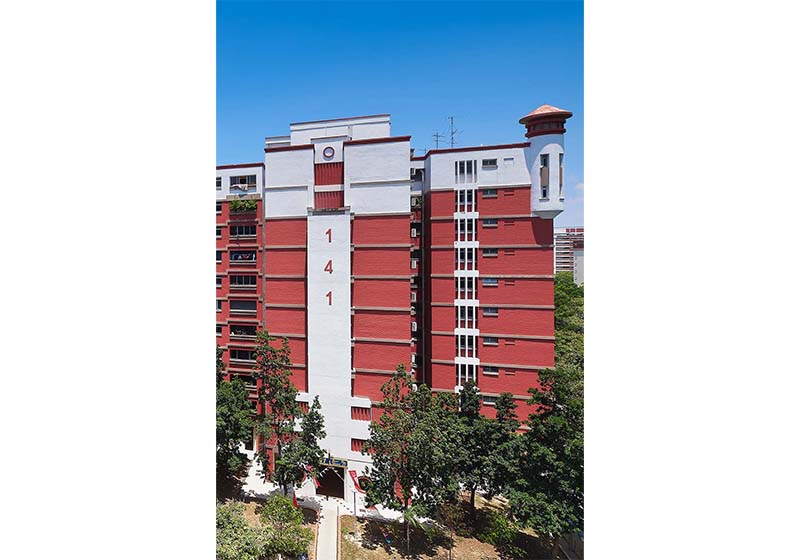
Over the years, more facilities and amenities were added to the estate. Pasir Ris Bus Interchange and Pasir Ris MRT station opened in December 1989, while Loyang Primary School and Loyang Secondary School were the first schools established there. (Both schools no longer exist as they have merged with other schools due to declining enrolments.)37
Some notable religious landmarks in the estate include Tibetan Buddhist temple Sakya Tenphel Ling, Pentecost Methodist Church, Church of Divine Mercy and Masjid Al-Istighfar.
In November 2011, the Pasir Ris Sports Centre was officially opened. The centre houses an indoor sports hall, swimming pools, futsal and tennis courts, a gym, food outlets and sporting goods shops.38 Next to it is the estate’s first hawker centre, Pasir Ris Central Hawker Centre, which opened in November 2017.39 Shopping malls such as White Sands, Loyang Point, Elias Mall and Pasir Ris West Plaza cater to residents’ shopping and dining needs.40
A Recreational and Entertainment Hub
Downtown East – a lifestyle, leisure and entertainment hub located at Pasir Ris Close – is one of Pasir Ris’ most recognisable landmarks. It was formerly known as NTUC Pasir Ris Resort, and was officially opened in 1988. The 14.7-hectare site offered chalets, swimming pools, a discotheque, squash and tennis courts, and play areas for children.41
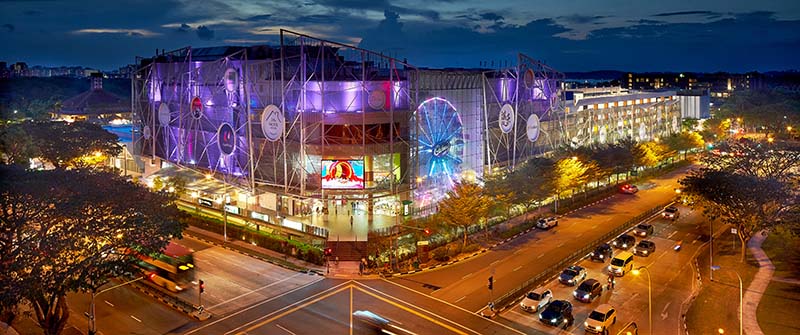
The resort was redeveloped and renamed Downtown East in 2000. New amenities included Escape Theme Park, an outdoor theme park, which opened in May 2000, and water theme park Wild Wild Wet, which began operations four years later. Both parks became highly popular among Singaporeans and tourists.42
In 2008, E!hub, a new five-storey one-stop leisure and entertainment centre – comprising a cinema, a family play centre, gaming arcades, a bowling centre as well as retail and dining outlets – opened in Downtown East. Although Escape Theme Park closed in 2011, D’Resort @ Downtown East opened on its site and welcomed its first guests in July 2015. Wild Wild Wet was also enlarged in 2016.43
Today, Pasir Ris continues to be well loved by residents and is a popular retreat spot for Singaporeans. On weekends and public holidays, families and groups of young people continue to fill the rooms of the holiday chalets at Downtown East. Some pitch tents by the sea while others gather for beachside picnics or barbecue sessions.
In 2017, the HDB announced that Pasir Ris would be rejuvenated under the Remaking Our Heartland programme. In the works are new flats, more retail outlets, a town plaza for community activities and a mixed-use development integrated with a bus interchange. A key feature of the facelift is a 1.2-kilometre-long Central Greenway, where an elevated section of the greenway will enable residents to walk from Pasir Ris MRT station to Pasir Ris Park in 10 minutes.44
Nur Aireen Abdullah, who has lived in Pasir Ris for more than 30 years, looks forward to a refreshed neighbourhood when the works are completed. “I will probably not move out from Pasir Ris. I love it here as it holds the memories of my happy childhood and there are plenty of things to do here. I look forward to exploring the new recreational facilities and community spaces with my family,” she said.45
 Asrina Tanuri is a Librarian (Research) with the National Library, Singapore. She is part of the Statutory Functions and Research team and is involved in content development, and reference and research services.
Asrina Tanuri is a Librarian (Research) with the National Library, Singapore. She is part of the Statutory Functions and Research team and is involved in content development, and reference and research services.Notes
https://www.pa.gov.sg/our-programmes/passion-wave/passionwave-pasirris/.
-
“Saudagar Minyak Urat / Love Crazy (1959),” Singapore Film Locations Archive, 2 February 2015, https://sgfilmlocations.com/2015/02/02/saudagar-minyak-urat-love-crazy-1959/. ↩
-
“Hotelier Building Seaside Resort on 130-acre Site,” Singapore Standard, 15 April 1952, 2; “4 Lawyers in Will Dispute,” Straits Times, 31 May 1951, 8; Lesley Koh, “Hidden Treasure,” Straits Times, 4 December 1992, 1. (From NewspaperSG); Victor R. Savage and Brenda S.A. Yeoh, Singapore Street Names: A Study of Toponymics (Singapore: Marshall Cavendish Editions, 2023), 147. (From National Library, Singapore, call no. RSING 915.9570014 SAV-[TRA]) ↩
-
John Turnbull Thomson, Singapore Island Surveyed and Drawn by J.T. Thomson Government Surveyor Singapore 20th Dec.r 1844 (Singapore: Government Surveyor Singapore, 1844). (From BookSG); Charles Burton Buckley, An Anecdotal History of Old Times in Singapore: (With Portraits and Illustrations) from the Foundation of the Settlement Under the Honourable the East India Company, on February 6th, 1819, to the Transfer of the Colonial Office as Part of the Colonial Possessions of the Crown on April 1st, 1867. Vol. II (Singapore: Fraser & Neave, 1902), 565. (From National Library, Singapore, call no. RCLOS 959.57 BUC); The National Archives, UK, Map of Singapore Island, and Its Dependencies, 1852, map. (From National Archives of Singapore, accession no. SP006879); The National Archives, UK, Map of the Island of Singapore and Its Dependencies, 1873, map. (From National Archives of Singapore, accession no. D2016_000249) ↩
-
H.T. Haughton, “Notes on Names of Places in the Island of Singapore and Its Vicinity,” Journal of Straits Branch of the Royal Asiatic Society, no. 20 (1889): 75–82. (From JSTOR via NLB’s eResources website) ↩
-
Urban Redevelopment Authority (Singapore), Pasir Ris Planning Area: Planning Report 1995 (Singapore: Urban Redevelopment Authority, 1995), 8. (From National Library, Singapore, call no.: RSING 711.4095957 SIN) ↩
-
Survey Department, Singapore, Singapore Provisional Issue, 1953, map. (From National Archives of Singapore, accession no. TM000043); Singapore Land Authority, Singapore. Tampines, 1961, map. (From National Archives of Singapore, accession no. TM001090); Survey Department, Singapore, Singapore. Instrumental Plot – Tampines and Pasir Ris, 1970, map. From National Archives of Singapore, accession no. TM000663) ↩
-
“Mak Piah dan Laut Seperti Lagu dan Irama,” Berita Harian, 9 July 1986, 3; “Kisah Di Sebalik Nama2 Menarik di Kg Elias,” Berita Harian, 9 July 1986, 3; “Kampung Jadi Tumpuan Pengeluar Filem Melayu,” Berita Harian, 3 August 1985, 7. (From NewspaperSG) ↩
-
“Advertisement: Méliès ‘Round the World’ Films,” Moving Picture World 17, no. 3 (19 July 1913): 379. Internet Archive, https://archive.org/details/movingpicturewor17newy. ↩
-
Raphaël Millet, “Gaston Mèliès and His Lost Films of Singapore,” BiblioAsia 11, no. 1 (April–June 2016): 11–15. ↩
-
“Hotelier Building Seaside Resort on 130-acre Site,” Singapore Standard, 15 April 1952, 2; “4 Lawyers in Will Dispute,” Straits Times, 31 May 1951, 8. (From NewspaperSG) ↩
-
“Page 11 Advertisements Column 1,” Straits Times, 16 May 1952, 11; “Hotelier Building Seaside Resort on 130-acre Site”; “Page 2 Advertisements Column 2,” Straits Times, 17 May 1952, 2; “New Hotel by the Sea,” Straits Times, 18 May 1952, 3. (From NewspaperSG) ↩
-
Wendy Hutton, “Spend a Quiet Day at a Beach Hotel with Charming Atmosphere…,” New Nation, 29 May 1971, 4; “Beach Hotel Now an RAF Hostel,” Straits Times, 7 May 1959, 7; Sam Ran, “Hotel Shuts Doors for the Last Time,” Straits Times, 31 December 1983, 12. (From NewspaperSG) ↩
-
Hutton, “Spend a Quiet Day at a Beach Hotel with Charming Atmosphere…” ↩
-
Sam Ran, “Hotel Shuts Doors for the Last Time.” ↩
-
“Page 3 Advertisements Column 2,” Straits Times, 8 February 1969, 3; “Boating and Fishing for the Water-loving Tourist,” Eastern Sun, 12 February 1969, 3. (From NewspaperSG) ↩
-
SG HeritageFest, “Hello Pasir Ris! Mini Series – A Holiday Resort Town (Ep 1),” video, 2:05, 27 June 2020, Youtube, https://www.youtube.com/watch?v=lUrRaNLjs1g. ↩
-
“Court Orders Winding-up of Entertainment Complex,” Straits Times, 27 April 1971, 8; “Govt Buys Golden Palace Holiday Resort,” Straits Times, 18 March 1973, 5; “Salt Water Fish Pond to Open,” Weekend East, 25 October 1990, 2. (From NewspaperSG) ↩
-
“30 Holiday Flats,” New Nation, 5 November 1973, 3. (From NewspaperSG) ↩
-
Shen Swee Yong, “Now It’s Seaside Living for All,” Straits Times, 15 May 1969, 14; “Holiday Flats at Pasir Ris Offered for Rent,” Straits Times, 11 May 1972, 13. (From NewspaperSG) ↩
-
Magdalene Lum, “Club Singapura,” Straits Times, 29 June 1988, 1. (From NewspaperSG) ↩
-
“New PA Centre for Water Sports,” Straits Times, 24 August 1987, 13. (From NewspaperSG); “PAssion WaVe @ Pasir Ris,” People’s Association, last updated 8 July 2021, ↩
-
“Water Thrills on Big Ski Ramp,” Singapore Free Press, 21 February 1955, 16; “Colony Waterski-ing Gala on Sunday,” Straits Times, 16 February 1955, 13. (From NewspaperSG) ↩
-
Betty L. Khoo, “Johnny Is a Joker…,” New Nation, 15 October 1974, 11; Shen Swee Yong, “Hobby That Became a Business,” Straits Times, 31 December 1969, 9; Nellie Har, “How to Play Tourist and Enjoy It All,” Straits Times, 26 September 1970, 7; Julie Leong, “Last Day for Sentosa’s Coralarium,” New Paper, 30 October 1995, 9. (From NewspaperSG) ↩
-
Betty L. Khoo, “A Villa That Ernest Built…,” New Nation, 16 October 1974, 11. (From NewspaperSG); Har, “How to Play Tourist and Enjoy it All.” ↩
-
“Pasir Ris for Picnics,” Singapore Standard, 28 April 1956, 8. (From NewspaperSG); P.H. Meadows, “Opening of Pasir Ris Beach Resort on Sunday, Aug 17,” speech, Pasir Ris Beach Resort, 17 August 1958, transcript. (From National Archives of Singapore, document no. phm19580817001); Lim Yew Hock, “Opening of the Pasir Ris Beach Resort on Sunday, August 17, 1958, At 11.30 A.M.,” speech, Pasir Ris Beach Resort, 17 August 1958, transcript. (From National Archives of Singapore, document no. lyh19580817001) ↩
-
“2 Japanese Help in Park Design,” New Nation, 28 June 1978, 2. (From NewspaperSG) ↩
-
Ilene Aleshire, “Pasir Ris Park to Be Second Largest,” Straits Times, 7 December 1984, 16. (From NewspaperSG) ↩
-
Mardiana Abu Bakar, “Fun for All,” Straits Times, 22 February 1992, 7. (From NewspaperSG); “Pasir Ris Park,” National Parks Board, last updated 14 March 2023, https://www.nparks.gov.sg/gardens-parks-and-nature/parks-and-nature-reserves/pasir-ris-park. ↩
-
“Lorong Halus Wetland,” Public Utilities Board, last updated 27 July 2021, https://www.pub.gov.sg/abcwaters/explore/loronghaluswetland; Ong Dai Lin, “From Former Landfill to Wetland…,” Today, 5 March 2011, 3. (From NewspaperSG) ↩
-
“Another Estate at Pasir Ris Beach,” Straits Times, 24 August 1974, 28; Rohaniah Saini, “Kampung-style Living and Spirit in Pasir Ris Park,” Straits Times, 14 June 1988, 19. (From NewspaperSG) ↩
-
Rohaniah Saini, “Kampung-style Living and Spirit in Pasir Ris Park.” ↩
-
Wong Kim Hoh, “A Self-contained Community Amid Nature,” Straits Times, 10 June 2015, 5. (From Newslink via NLB’s eResources website) ↩
-
Mathew Yap, “Pasir Ris: A New Town by the Sea,” Straits Times, 28 October 1985, 1; “Land Acquired for New Housing Estate,” Business Times, 9 March 1983, 1. (From NewspaperSG) ↩
-
“Young Town, Vocal Residents,” Straits Times, 22 January 1995, 24. (From NewspaperSG) ↩
-
Nur Aireen Abdullah, interview, 1 November 2022. ↩
-
Wong, “A Self-contained Community Amid Nature.” ↩
-
“3 Stations Open Today,” Straits Times, 16 December 1989, 30; “Pasir Ris and Eunos Interchanges to Open on Sunday,” Straits Times, 7 December 1989, 18. (From NewspaperSG); “Our Story,” Casuarina Primary School, last updated on 9 March 2023, https://www.casuarinapri.moe.edu.sg/caps-connection/CAPS-Open-House/Our-Story/; Loyang Secondary School, 20 LYSS (Singapore: Loyang Secondary School, 2009). (From BookSG) ↩
-
Wayne Chan, “DPM Opens Sports Centre in Pasir Ris,” Today, 7 November 2011, 16. (From NewspaperSG) ↩
-
Siau Ming En, “Traditional Meets Hipster at New Pasir Ris Hawker Centre,” Today, 7 September 2017. 16. (From NewspaperSG) ↩
-
Ngiau Chean Fei, “Smiling Dolphins Greet Shoppers at White Sands,” Weekend East, 6 December 1996, 5; Cephah Tan, “3 New Shopping Centres for Pasir Ris,” Straits Times, 23 October 1994, 25. (From NewspaperSG) ↩
-
“PM Opens $38m Pasir Ris Holiday Resort for Workers,” Straits Times, 5 November 1988, 6. (From NewspaperSG) ↩
-
“Our Milestones,” NTUC Club, last accessed 22 March 2023, https://www.ntucclub.com/about-us/our-milestones. ↩
-
“Our Milestones.” ↩
-
Audrey Tan, “Remake to Boost Access to Charms of Pasir Ris,” Straits Times, 30 April 2017, 2–3; Audrey Tan, “Rejuvenating Pasir Ris,” Straits Times, 30 April 2017, 2–3. (From NewspaperSG) ↩
-
Nur Aireen Abdullah, interview, 1 November 2022. ↩

